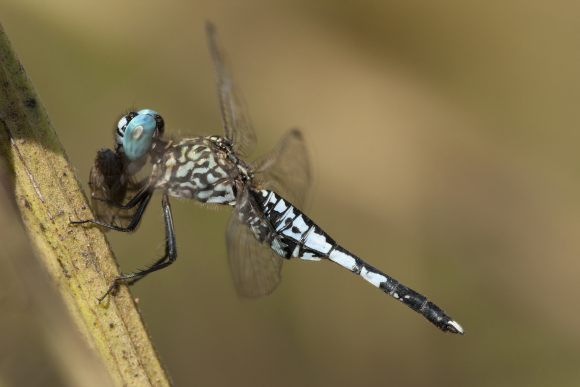Genus Acisoma Rambur, 1842
pintails
Type species: Acisoma panorpoides Rambur, 1842
Introduction
Until recently, two species were thought to occur in Africa, of which A. panorpoides extended to Asia and Madagascar. However, it appears the latter can be separated into one species in Asia (the true A. panorpoides), two in Madagascar and two in mainland Africa: A. inflatum and A. variegatum. The extent of their occurrence requires further study (e.g. what occurs in Rwanda and South Sudan), but they overlap widely and have been found on the same pools. All species are easily identified by their small size (hindwing 19-25 mm), unusual spindle-shaped abdomenomen, and bluish white markings. The African species like sunny and especially grassy marshes, A. trifidum preferring those in or near forest. Despite marked differences in mature males, females and fresh males are less distinctly marked and may be confused. [Adapted from Dijkstra & Clausnitzer 2014]
Diagnosis
Male of genus is similar to Porpax by (a) small size, Hw 19-29 mm; (b) head, thorax and Abd with fragmented white, yellow, green or turquoise markings, sometimes Abd pruinose; (c) frons and vertex ventrally black, dorsally usually with contrasting white, greenish or blue markings; (d) occipital triangle large with rather straight borders, eyes at most touching over distance less than half its length; (e) distal Ax in Fw incomplete, its subcostal section absent (indicated as ‘½’ when Ax are counted); (f) 1 cell-row in radial planate; (g) Hw at most with small dark patch at extreme base. However, differs by (1) arculus in all wings proximal to Ax2; (2) Fw triangle of 1 cell, subtriangle of 1-2 cells, rarely 3; (3) 7½-8½ Ax in Fw, rarely 9½; (4) always 1 Cux in Hw; (5) Abd swollen at base, slender at tip; (6) S4 with transverse ridge of similar strength as that on S3 and lateral carina S4. [Adapted from Dijkstra & Clausnitzer 2014]

Acisoma trifidum Kirby, 1889. Male © Jens Kipping

Acisoma inflatum Selys, 1882. Male © Wil Leurs
Map citation: Clausnitzer, V., K.-D.B. Dijkstra, R. Koch, J.-P. Boudot, W.R.T. Darwall, J. Kipping, B. Samraoui, M.J. Samways, J.P. Simaika & F. Suhling, 2012. Focus on African Freshwaters: hotspots of dragonfly diversity and conservation concern. Frontiers in Ecology and the Environment 10: 129-134.
References
- Dijkstra, K.-D.B, and Clausnitzer, V. (2014). The Dragonflies and Damselflies of Eastern Africa: handbook for all Odonata from Sudan to Zimbabwe. Studies in Afrotropical Zoology, 298, 1-264.
- Ris, F. (1921). The Odonata or Dragonflies of South Africa. Annals South African Museum, XVIII, 245-452. [PDF file]
- Lieftinck, M.A. (1969). Odonates Anisoptères - Odonata Anisoptera. Explor. hydrob. Lac Bangweolo and Luapula, 14, 1-64. [PDF file]
Citation: Dijkstra, K.-D.B (editor). African Dragonflies and Damselflies Online. http://addo.adu.org.za/ [2024-10-30].

